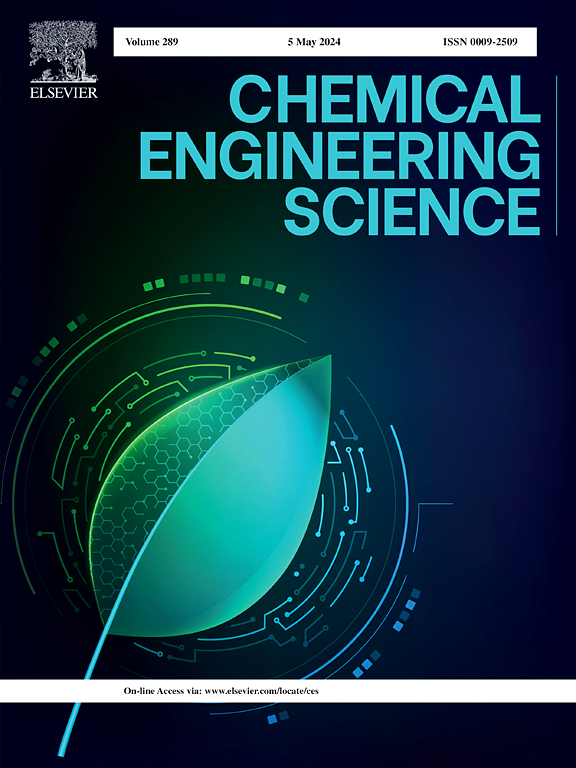液滴通过不同长度分支t结的不对称分裂行为研究
IF 4.1
2区 工程技术
Q2 ENGINEERING, CHEMICAL
引用次数: 0
摘要
利用具有不同分支长度的t结微通道被认为是不对称分裂生成不同尺寸微滴的首选方法。本研究设计了一种不同长度分支的t结微流控芯片,搭建了微流控芯片中液滴不对称分裂可视化实验平台,重点研究了微流控液滴不对称分裂行为。通过对劈裂过程中界面演化和特征界面形态参数变化的详细分析,清晰地认识了劈裂流动模式,揭示了劈裂流动的水动力机制。揭示了不对称劈裂体积比的影响因素及其调节规律。结果表明,液滴不对称劈裂过程中存在4种流动模式,即有障碍物和通道的劈裂(SOT)、有通道和后续液滴反方向流动的劈裂(ST-O)、有通道和后续液滴同方向流动的劈裂(ST-S)和无劈裂(NOS)。给出了液滴分裂流型的相图。在一定毛细数下,随着初始液滴长度的增加,分裂流型经历了从NOS到SOT的过渡,经过ST-S和ST-O。分裂过程包括三个不同的阶段:进入阶段、挤压分裂阶段和分裂后阶段。在挤压和分裂阶段,上游连续相挤压和界面张力的竞争导致液滴颈部不均匀收缩导致不对称分裂。此外,在SOT流型中,液滴最终分裂体积比(Vl/Vs)随液滴长度的增加而增加,而在ST-O和ST-S流型中随液滴长度的增加而减小。重要的是,在相同液滴长度下,随着Ca的增加,SOT模式的最终Vl/Vs保持相似。ST-O和ST-S型的最终Vl/Vs随Ca的增加而减小。本文章由计算机程序翻译,如有差异,请以英文原文为准。
Investigation on asymmetric splitting behavior of droplets through T-junction with different-length branches
The utilization of T-junction microchannels with different lengths of branches is considered as the preferred method for asymmetric splitting to generate microdroplets with various sizes. In this study, a T-junction microfluidic chip with different-length branches is designed and an experimental platform is set up to visualize droplet asymmetric splitting in the chip, with a focus on elucidating microfluidic droplet asymmetric splitting behaviors. Through detailed analysis of the interface evolution and changing of the characteristic interface morphological parameters during the splitting process, the splitting flow patterns are clearly recognized and the underlying hydrodynamic mechanisms are revealed. Moreover, the influencing factors and their regulation rules on the asymmetric splitting volume ratios are also exposed. The results indicate that there are four types of flow patterns during droplet asymmetric splitting, i.e., splitting with obstruction and tunnel (SOT), splitting with tunnels and consequent droplets flowing in the opposite direction (ST-O), splitting with tunnels and consequent droplets flowing in the same direction (ST-S), and no splitting (NOS). A phase diagram of droplet splitting flow patterns is given. With the increasing initial droplet length for a given Capillary number, the splitting flow pattern experiences a transition from the NOS to the SOT through the ST-S and the ST-O. The splitting process comprises three distinct stages: the entering stage, the squeezing and splitting stage, and the post-splitting stage. During the squeezing and splitting stage, the competition of upstream continuous phase squeezing and interfacial tension causes asymmetric splitting by uneven shrinkage of the droplet neck. Additionally, it is found that the droplet final splitting volume ratio (Vl/Vs) increases with droplet length in the SOT flow pattern, while it decreases with droplet length in the ST-O and ST-S flow patterns. Importantly, the final Vl/Vs of the SOT pattern remains similar with increasing Ca for the same droplet length. However, the final Vl/Vs of the ST-O and ST-S pattern decreases with increasing Ca.
求助全文
通过发布文献求助,成功后即可免费获取论文全文。
去求助
来源期刊

Chemical Engineering Science
工程技术-工程:化工
CiteScore
7.50
自引率
8.50%
发文量
1025
审稿时长
50 days
期刊介绍:
Chemical engineering enables the transformation of natural resources and energy into useful products for society. It draws on and applies natural sciences, mathematics and economics, and has developed fundamental engineering science that underpins the discipline.
Chemical Engineering Science (CES) has been publishing papers on the fundamentals of chemical engineering since 1951. CES is the platform where the most significant advances in the discipline have ever since been published. Chemical Engineering Science has accompanied and sustained chemical engineering through its development into the vibrant and broad scientific discipline it is today.
 求助内容:
求助内容: 应助结果提醒方式:
应助结果提醒方式:


